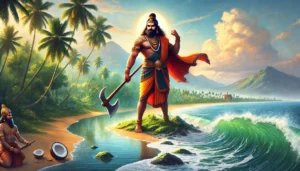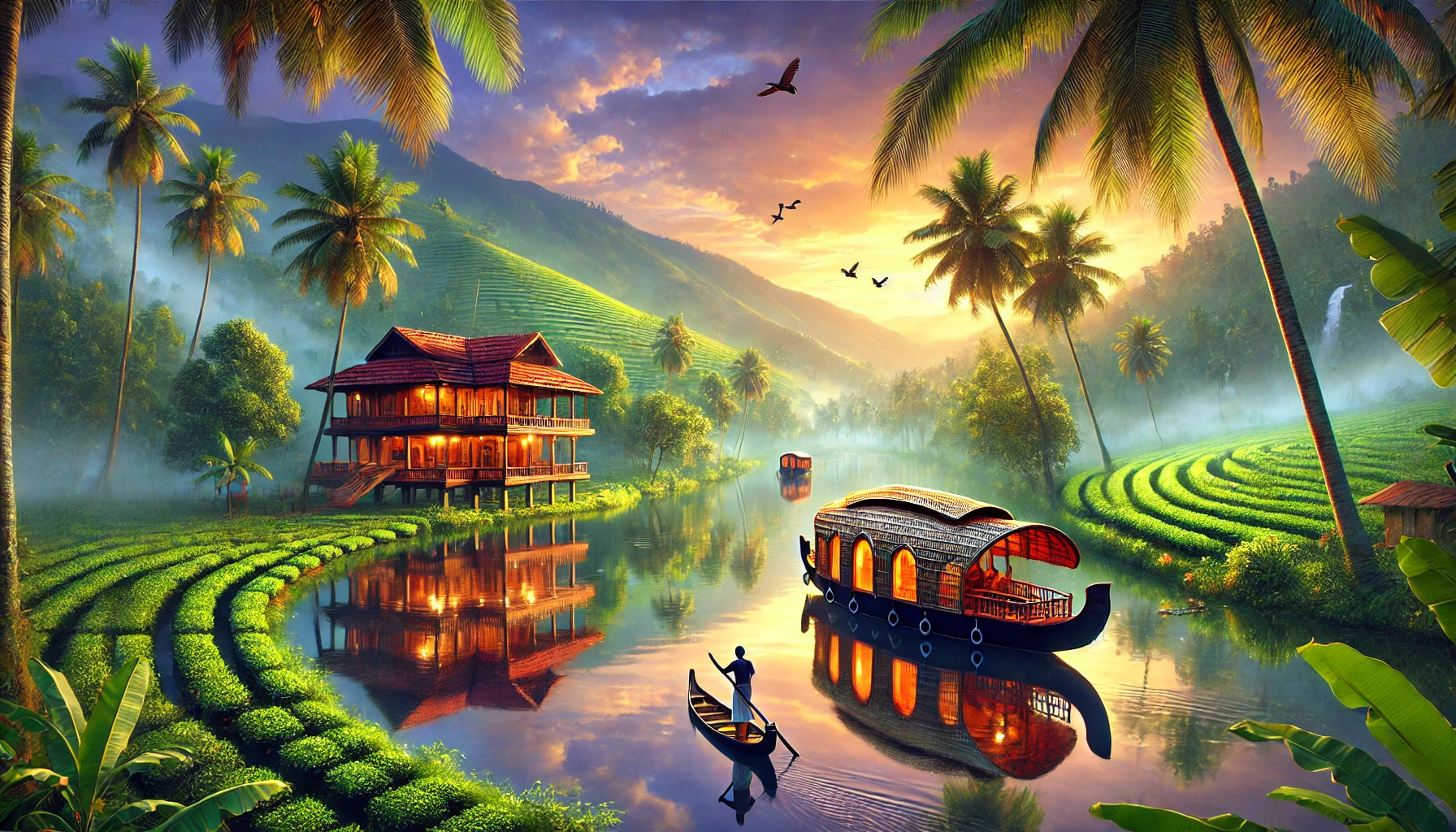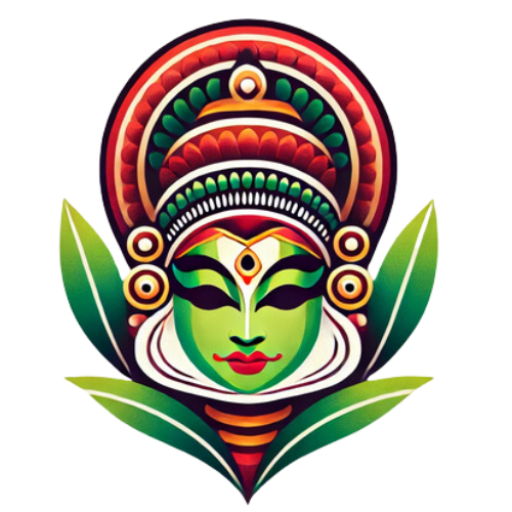Kerala, often called “God’s Own Country,” is located on India’s southwestern coast, bordered by the Arabian Sea to the west and the lush Western Ghats to the east. Known for its breathtaking landscapes, tranquil backwaters, and diverse culture, Kerala is a blend of natural beauty, centuries-old traditions, and an enduring connection to mythology. This land has seen the footprints of ancient dynasties, global traders’ influence, and divine legends’ presence. Kerala’s charm lies in how its landscapes, temples, art forms, and festivals embody the cultural continuity, spirituality, and progress that characterize this enchanting state.
The Mythical Creation of Kerala by Parasurama

The origin story of Kerala is steeped in myth, beginning with the tale of Parasurama, the sixth avatar of Lord Vishnu. According to Hindu legend, Parasurama reclaimed Kerala from the Arabian Sea by throwing his battle axe from Gokarna in Karnataka. As the axe fell, the sea retreated, and a narrow strip of land emerged, which became Kerala. This divine act of land reclamation is believed to have endowed Kerala with its fertile soil, abundant rivers, and unique coastal geography. Parasurama then invited Brahmins to settle in this land, establishing the spiritual foundation upon which Kerala’s unique culture would flourish.
This legend gives Kerala its sacred status and contributes to its spiritual atmosphere, presenting it as a land created and blessed by divine will. Parasurama’s influence is still honoured in Kerala, with several temples and rituals dedicated to his legacy, adding a spiritual layer to the state’s cultural landscape.
The Ramayana’s Sacred Footprints in Kerala
Kerala is interwoven with tales from the Ramayana, one of India’s most revered epics. Legends recount that Lord Rama and Sita traveled through Kerala during their exile. One such tale unfolds in Wayanad, a picturesque district known for its lush greenery and misty hills. According to local folklore, Lord Rama and Sita visited Wayanad, drawn by its serenity and beauty. There, they rested beside a sacred pond, said to have formed when Lord Rama struck the ground with his arrow to quench Sita’s thirst. This pond, now a place of reverence, reflects Kerala’s enduring connection to ancient legends.
Another tale holds that after the war with Ravana, Lord Rama, feeling conflicted over his subjects’ doubt in Sita’s purity, decided to part from her. He banished Sita to Pulpally, a quiet town in Wayanad, where she lived in exile and gave birth to their twin sons, Luv and Kush. Today, Pulpally is home to the Seetha Devi Lava Kusha Temple, one of the rare temples dedicated to Sita and her sons. Adjacent to this temple is a pond known as Sita Kulam or Sita’s Pond, which, according to local belief, was formed by the tears she shed upon being left by Rama. With its tranquil environment and spiritual significance, the temple draws pilgrims who honour Sita’s resilience and strength.
The Seetha Devi Lava Kusha Temple is open daily from 6:00 AM to 11:30 AM and from 4:30 PM to 8:30 PM, and there is no entry fee, making it an accessible place for those seeking to connect with this divine tale. This temple and pond embody Kerala’s sacred ties to the Ramayana, adding a spiritual dimension to the enchanting beauty of Wayanad.
Chera Dynasty and Kerala’s Early History
In historical records, Kerala is prominently associated with the Chera Dynasty, one of the earliest ruling dynasties in South India. The Cheras established trade relations with ancient Rome, Greece, and the Middle East, capitalizing on Kerala’s wealth of spices, ivory, and precious stones. From the 1st century BCE to the 2nd century CE, Sangam literature documents the Chera rulers and their influence, describing a society that valued art, literature, and governance. This period saw the construction of temples, the promotion of Dravidian architecture, and the rise of a culturally vibrant society that set the foundation for Kerala’s identity.
Following the Cheras, Kerala saw the rise of the Zamorin Kingdom in Calicut. The Zamorin rulers continued Kerala’s legacy as a trading hub, particularly with the arrival of Portuguese explorers led by Vasco da Gama in 1498. European trade led to further cultural exchanges, with the Portuguese, Dutch, and British each leaving their mark on Kerala’s architecture, economy, and society.
Colonial Influence and Cultural Synthesis
Kerala’s encounter with European colonization began with the arrival of the Portuguese in the 15th century, who established a trading monopoly along the Malabar Coast. The Dutch and the British followed them, each contributing to Kerala’s cultural and architectural diversity. Churches such as the St. Francis Church in Kochi, one of the oldest European churches in India, stand as testaments to European influence. The Santa Cruz Basilica and several other historic churches highlight the integration of Portuguese, Dutch, and British styles into Kerala’s architectural heritage.
The Mattancherry Palace, gifted by the Portuguese to the King of Cochin, is another architectural marvel. Known as the Dutch Palace due to later renovations by the Dutch, it features murals depicting Hindu mythology, including scenes from the Ramayana and Mahabharata, illustrating Kerala’s openness to diverse cultural influences. These structures remain iconic landmarks, symbolizing the fusion of Kerala’s indigenous architecture with colonial elements.
Kerala’s Architectural Marvels: Temples, Palaces, and Historical Monuments
Kerala’s architectural legacy reflects its cultural diversity. The Padmanabhaswamy Temple in Thiruvananthapuram, dedicated to Lord Vishnu, is one of India’s wealthiest and most revered temples. Built-in the Dravidian style, the temple features intricate carvings, towering gopurams, and remarkable treasures hidden in its underground chambers, symbolizing Kerala’s spiritual and material wealth.
The Padmanabhapuram Palace, constructed with indigenous techniques, is a masterpiece of Kerala architecture, featuring rosewood carvings, expansive courtyards, and exquisite murals. The Napier Museum in Thiruvananthapuram combines Gothic and Kerala architectural styles, housing ancient artefacts, bronze idols, and ivory carvings that narrate Kerala’s artistic and historical journey.
The Kerala Backwaters: A Tranquil Waterway of Culture and Tradition
Kerala’s backwaters, a labyrinth of canals, rivers, and lakes, span over 900 kilometres, creating a peaceful haven that mirrors Kerala’s natural beauty. This ecosystem supports a diverse range of flora and fauna and sustains traditional lifestyles. Houseboats, or kettuvallams, are an iconic sight on these waters, offering tourists a serene experience of Kerala’s rural life. Originally used to transport goods like rice and spices, these kettuvallams have been transformed into comfortable houseboats that take visitors through the villages, showcasing traditional farming and fishing practices.
The backwaters, especially in places like Alleppey and Kumarakom, are a sanctuary of tranquillity, embodying the harmonious relationship between humans and nature. They hold ecological and cultural significance, offering visitors a glimpse into Kerala’s history, where water routes played a vital role in trade and daily life.
The Spice Trade and Culinary Heritage of Kerala
Kerala’s global fame as the “Spice Garden of India” dates back thousands of years. Its spices—mainly black pepper, cardamom, cinnamon, and cloves—were once as valuable as gold, drawing merchants from Greece, Rome, the Middle East, and China. The spice trade shaped Kerala’s economy and cultural identity, making it a bustling centre for global commerce. Today, spice markets in Kochi and the lush tea plantations of Munnar continue to captivate visitors, carrying forward the legacy of Kerala’s spice heritage.
Kerala’s cuisine, heavily influenced by this trade, is known for its bold flavours and use of coconut, curry leaves, and various spices. Traditional meals like Sadhya served on banana leaves, feature up to 26 dishes, showcasing the diversity of Kerala’s ingredients. Seafood also plays a significant role in the cuisine, with dishes like fish molee (a mild fish curry with coconut milk) reflecting the influence of Portuguese cooking. At the same time, Malabar biryani bears traces of Arab flavours.
Religious Harmony and Unity in Diversity
Kerala is renowned for its spirit of religious harmony, with communities of Hindus, Muslims, Christians, and others coexisting peacefully for centuries. This harmony is reflected in Kerala’s festivals and interfaith celebrations. The Cheraman Juma Masjid in Kodungallur, India’s oldest mosque, built in 629 CE, and temples and churches situated side by side are a testament to Kerala’s inclusive ethos.
Onam, Kerala’s grand harvest festival, is celebrated by all communities, transcending religious boundaries. Other festivals like Vishu, the Malayali New Year, and Thrissur Pooram, with its vibrant elephant processions and fireworks, reflect Kerala’s cultural unity. These festivals, rooted in both Hindu legends and secular traditions, celebrate Kerala’s inclusivity and joyful spirit.
Educational Achievements and Social Welfare
Kerala’s impressive literacy rate and educational achievements result from a long history of social reform. Social visionaries like Sree Narayana Guru and Ayyankali championed education to uplift society, emphasizing equality and empowerment. Today, Kerala’s commitment to public education and healthcare has transformed it into a model for social progress, with high literacy rates and gender equality central to its development.
Kerala’s progressive governance model, known as the Kerala Model, focuses on human development and social welfare. Through education, healthcare, and environmental sustainability policies, Kerala has achieved high human development indicators, setting a standard for inclusive growth and public welfare.
Tourism and Ecotourism Initiatives in Kerala
Kerala’s tourism industry is a major contributor to its economy, combining eco-friendly practices with community involvement. From the hill stations of Munnar, known for their tea plantations, to the sunny beaches of Kovalam and Varkala, Kerala attracts visitors with diverse landscapes. Eco-tourism initiatives like the Responsible Tourism Mission promote sustainable practices that benefit local communities and preserve Kerala’s natural beauty.
Conclusion: A Living Tapestry of History, Myth, and Modernity
Kerala is more than a destination; it’s a journey through myth, history, and cultural richness. From the divine legends of Parasurama, Rama, and Sita to the architectural grandeur of temples and palaces, Kerala holds a unique place in India’s cultural heritage. Its scenic backwaters, vibrant festivals, and inclusive ethos make Kerala a land where ancient traditions thrive alongside modern achievements. “God’s Own Country” offers visitors a timeless experience, bridging the past and present, and stands as a symbol of spiritual depth, natural beauty, and progressive ideals.








![Please Subscribe our channel - http://goo.gl/NjWnRS
Give us a Super Thanks
#mohanlal #chithram #malayalmsongs #malayalammoviesongs #malayalammovie
Actors: Mohanlal, Sreenivasan
Directors: Priyadarsan
Chithram Malayalam Full Movie HD | Mohanlal Evergreen Movie
Chithram (English: Picture) is a 1988 Indian Malayalam-language screwball comedy film written and directed by Priyadarshan. The film was produced by P. K. R. Pillai for Shirdi Sai Creations, and stars Mohanlal, Ranjini, Nedumudi Venu, Poornam Vishwanathan, Sreenivasan, M. G. Soman, Sukumari, Lizy, Maniyanpilla Raju, and Shanavas, while Thikkurissy Sukumaran Nair makes a cameo appearance. The songs were composed by Kannur Rajan and film score by Johnson.
Kalyani (Ranjini) decides to marry her boyfriend Ravi (Shanavas) against her father Ramachandra Menon's (Vishwanathan) wishes. But Ravi breaks up when he comes to know that she would be disinherited. Kalyani's father, who stays in the United States, is unaware of the break up and comes home in Kerala to spend time with his daughter and son-in-law. This prompts family friend and Advocate Kaimal (Venu) to hire a thief, Vishnu (Mohanlal) to act as Kalyani's husband during Menon's vacation stay.
Chithram was released during a Christmas weekend on 23 December 1988. The film was a phenomenal success at the Kerala box-office, it broke all existing records in Malayalam cinema until then.[1] It had a theatrical run of more than 366 days in Ernakulam Little Shenoys, with regular shows, and theatrical run of 300 days in Thiruvananthapuram Ajantha and more than 200 days in Kottayam Asha, Palakkad Priya, Chengalai Chithra with noon shows. It is one of the highest-grossing films in Malayalam film history.[2] It collected more than ₹3 crore from theatres
Please Subscribe our channel.- http://goo.gl/NjWnRS
mohanlal hit movies in malayalam
mohanlal comedy movies
#Malayalam #mohanlalevergreenmovie #comedy](https://i.ytimg.com/vi/THew2hCgCDs/maxresdefault.jpg)
![Please Subscribe our channel - http://goo.gl/NjWnRS
Give us a Super Thanks
#mohanlal #chithram #malayalmsongs #malayalammoviesongs #malayalammovie
Actors: Mohanlal, Sreenivasan
Directors: Priyadarsan
Chithram Malayalam Full Movie HD | Mohanlal Evergreen Movie
Chithram (English: Picture) is a 1988 Indian Malayalam-language screwball comedy film written and directed by Priyadarshan. The film was produced by P. K. R. Pillai for Shirdi Sai Creations, and stars Mohanlal, Ranjini, Nedumudi Venu, Poornam Vishwanathan, Sreenivasan, M. G. Soman, Sukumari, Lizy, Maniyanpilla Raju, and Shanavas, while Thikkurissy Sukumaran Nair makes a cameo appearance. The songs were composed by Kannur Rajan and film score by Johnson.
Kalyani (Ranjini) decides to marry her boyfriend Ravi (Shanavas) against her father Ramachandra Menon's (Vishwanathan) wishes. But Ravi breaks up when he comes to know that she would be disinherited. Kalyani's father, who stays in the United States, is unaware of the break up and comes home in Kerala to spend time with his daughter and son-in-law. This prompts family friend and Advocate Kaimal (Venu) to hire a thief, Vishnu (Mohanlal) to act as Kalyani's husband during Menon's vacation stay.
Chithram was released during a Christmas weekend on 23 December 1988. The film was a phenomenal success at the Kerala box-office, it broke all existing records in Malayalam cinema until then.[1] It had a theatrical run of more than 366 days in Ernakulam Little Shenoys, with regular shows, and theatrical run of 300 days in Thiruvananthapuram Ajantha and more than 200 days in Kottayam Asha, Palakkad Priya, Chengalai Chithra with noon shows. It is one of the highest-grossing films in Malayalam film history.[2] It collected more than ₹3 crore from theatres
Please Subscribe our channel.- http://goo.gl/NjWnRS
mohanlal hit movies in malayalam
mohanlal comedy movies
#Malayalam #mohanlalevergreenmovie #comedy](https://artkerala.com/wp-content/plugins/youtube-feed-pro/img/placeholder.png)

വേദിയിൽ പാട്ടു പാടി ഞെട്ടിച്ചു കമൽ ഹാസൻ.. S T R എന്ന് പറഞ്ഞപ്പോൾ ഇളകി മറിഞ്ഞു ഫോറം മാൾ 🔥| Thug Life
Choice Movie News 8 hours ago